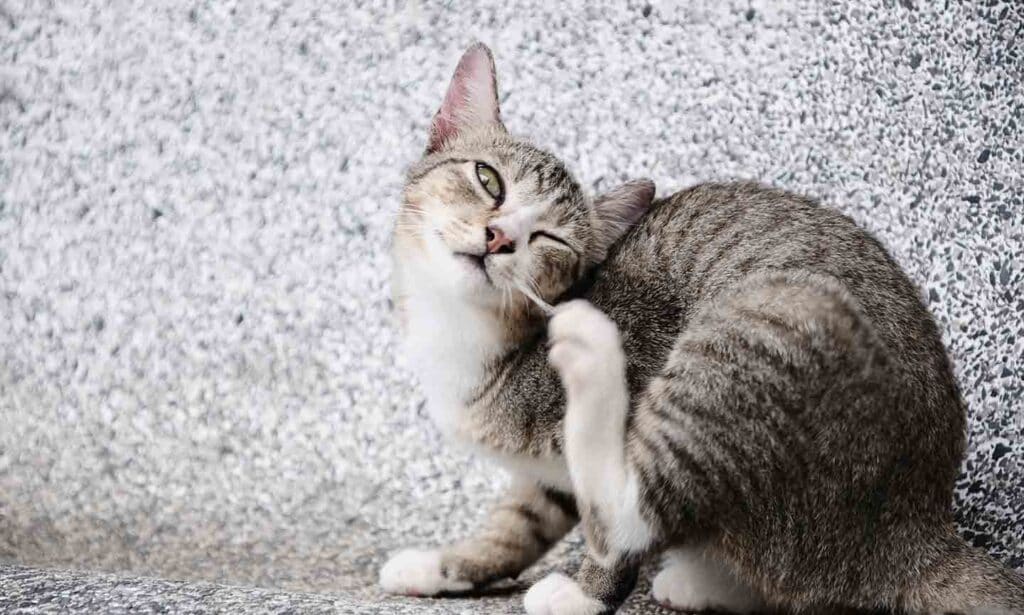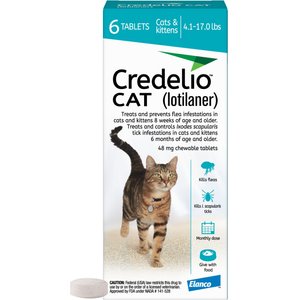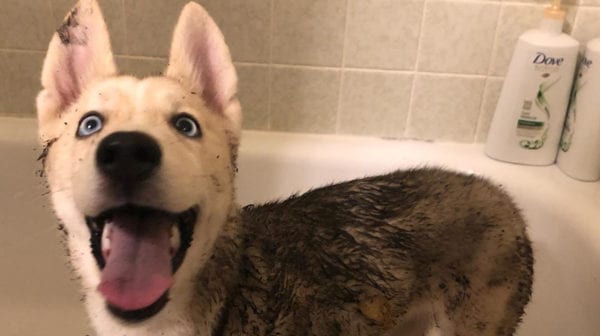In This Guide
What Are Hot Spots on Cats?
Also known as acute moist dermatitis and pyotraumatic dermatitis, hot spots on cats are superficial skin infections that occur suddenly. A hot spot happens when a cat licks, chews, scratches or bites their skin enough to make it raw. A cat’s skin normally has certain types of bacteria and yeast living on it with no problems. However, when the skin is irritated, bacteria overgrowth can create dermatitis, a full-blown skin infection.
While any cat can get a hot spot, certain types may be more prone to them:
- Long-haired and thick-coated cats may be more prone because of matting that can trap debris and saliva under the fur.
- Older or disabled cats who can’t groom themselves well may be at increased risk, too.
- Outdoor cats who come into contact with parasites are also at increased risk for hot spots.
Hot spots occur year round but are more common during warm, humid summer months, when biting or sucking parasites and allergies are active. Hot spots can happen anywhere on the body, but they tend to be seen on a cat’s:
- Face/chin
- Neck
- Belly
- Lateral thigh
- Around the base of the tail
Hot spots are common in dogs but rare in cats.
What Do Hot Spots on Cats Look Like?
Hot spots have a very distinct look. They appear suddenly, are very itchy and have the following qualities:
- Get bigger very quickly
- Well-defined edges
- Redness
- Hair loss
- Weepy, moist and raw skin
- Painful
Hot spots typically show up as one single lesion, but there can also be multiple hot spots. Hot spots can also be hidden by matted hair.
What Causes Hot Spots on Cats?
Hot spots occur in the following sequence:
- Something makes the cat’s skin itchy or irritated.
- The cat bites, chews or scratches themselves raw, creating a bald, red, oozing hot spot.
- Staphylococcus (bacteria usually considered normal flora for cat skin) overgrows and causes a localized skin infection on the abraded, damaged skin.
- The cat licks the hot spot more, creating a vicious cycle.
Hot spots on cats aren’t primary skin diseases; they are almost always an indicator of an underlying skin disorder that is making the cat itchy. Causes of hot spots in cats can include:
- External parasites, including fleas, mites and ticks
- Other stinging or biting insects, such as mosquitoes, bees or ants
- Allergies. The most common skin allergies in cats are flea allergy, food allergy and atopic dermatitis (seasonal allergies)
- Contact dermatitis from hypersensitivity to a detergent or cleaning product
- Overgrooming from stress, anxiety or compulsive disorders
- Overgrooming from joint pain or anal gland pain
- Overgrooming a wound
- Ear infections and/or ear mites
When to Go to the Veterinarian for Hot Spots
These skin lesions are usually painful, and in general should be treated by a veterinarian as soon as possible. On occasion, a small hot spot may resolve on its own if the inciting factor is removed. However, if the hot spot hasn’t started to dry up and improve within one day, it is unlikely to heal quickly. The hot spot may cause scarring and is painful for your cat, so take your cat to the vet if it hasn’t improved within a day and seems to be getting worse—or your cat won’t leave it alone or you are worried.
Veterinarians diagnose cat hot spots by asking questions about your cat and conducting a full physical examination. Your veterinarian may want to run skin tests to rule out other conditions; in rare cases, they may recommend biopsying the lesion if the inciting cause is not readily apparent or it is not responding to treatment. In most cases, they will be able to tell you what causes the hot spot and how to prevent it from happening again.
Hot Spots on Cats Treatment
Every veterinarian has their own way to treat hot spots, but in general, treating cat hot spots involves a five-step process:
- Removing all the hair on and around the hot spot with clippers.
- Cleansing and drying the infected skin.
- Testing (if necessary) to diagnose the cause.
- Applying a topical medication that contains corticosteroids, or a numbing agent to reduce pain and inflammation, and administering antibiotics (if necessary) to fight the bacterial infection.
- Fitting the cat with a device (recovery cone, T-shirt, etc.) that will prevent them from licking/scratching the hot spot. This will allow the skin to heal.
Hot spots are painful. Some cats will need to be sedated for the clipping and cleaning procedure, and your veterinarian may prescribe pain medication such as Onsior to be given at home.
Your cat will likely be treated with antibiotics (either a one-time injection or oral medication to be given at home). Your cat may also be prescribed a topical medication to be applied to the hot spot at home to help it heal.
Keep giving the medication as prescribed, even if the hot spot looks better, and treat the hot spot for the length of time as directed by your veterinarian. In addition, keep the recovery cone or T-shirt in place until your veterinarian gives you the all clear, as removing these bite-prevention devices too early can result in your cat damaging their skin and putting everybody back at square one.
How Long Does It Take for Hot Spots to Heal?
Depending on the underlying cause, hot spots can heal in as little as a week or they can take much longer. Your veterinarian will help manage your expectations. Most hot spots resolve quickly once the underlying cause is resolved.
In addition to treating the skin infection, it is critical to deal with the underlying issue that is causing the hot spot or they will reoccur. If your cat’s hot spot was caused by external parasites such as fleas, the fleas need to be eliminated either with prescription flea medication or flea shampoo. If your cat has hot spots due to allergies, your veterinarian will help determine what kind of allergy your cat has and how best to manage that condition.
Hot Spot Spray for Cats
Some veterinarians will prescribe a spray for the hot spot. These sprays typically contain a corticosteroid and an antibiotic. It is important that the cat does not groom off or ingest the spray, however; if your cat is prescribed a medicated spray, use as directed, and prevent your cat from licking the spray by using a recovery cone or other anti-chewing device.
Can I Treat Cat Hot Spots With a Home Remedy?
If you notice a hot spot on your cat, you may be tempted to treat it at home with over-the-counter human medications such as cortisone cream or triple antibiotic ointment. Human OTC products are usually not strong enough to stop the pain or itching, however, and most cats will just lick the medication off as soon as you apply it. This can cause further issues when a cat consumes medication, as many human products have ingredients that are toxic to cats.
Further, cat hot spots can get worse quickly, as the cat will continue to bite, chew or scratch itchy or painful skin. For all of these reasons, home remedies are not recommended for cat hot spots.
If you notice a hot spot on your cat, go to the veterinarian the same day if possible. If you can’t, call your veterinarian for advice on how to manage the hot spot until you can get an appointment.
Can I Use Coconut Oil for Cat Hot Spots?
Coconut oil for cat hot spots is not recommended; it will not resolve the issue and may make it worse. While coconut oil does have beneficial properties for skin, it is not indicated for skin that is infected or raw. In addition, coconut oil is high in fat and can make your cat sick if they accidentally ingest it while self grooming. Do not use coconut oil on cats for hot spots.
How to Prevent Hot Spots on Cats
The best way to prevent hot spots on cats is to avoid exposing them to things that cause hot spots. This can include:
- Consistently using flea and tick prevention on your cat to prevent flea allergies.
- Working with your local veterinarian or a board-certified veterinary dermatologist to diagnose and treat other allergies.
- If your cat has seasonal allergies (atopic dermatitis), options for treatment include avoiding the allergen, immunotherapy, antihistamines or other prescription-strength allergy medication.
- If your cat has food allergies, work with your veterinarian to conduct a food-elimination trial and/or feed your cat a therapeutic, hypoallergenic food.
- Have ear mites and/or ear infections treated promptly.
- Provide environmental enrichment and appropriate resources to your cat to reduce stress.
- Talk to your veterinarian about pain control for joint disorders that might cause over-grooming.
- Consider giving your cat a high-quality fish oil supplement, which has been shown to benefit skin health.
- Take your cat to the vet annually to catch any problems early.
FAQs About Hot Spots on Cats
Q:
Will hot spots go away on their own?
Q:
Are cat hot spots contagious?
Ease Your Cat's Itch
Share:
















